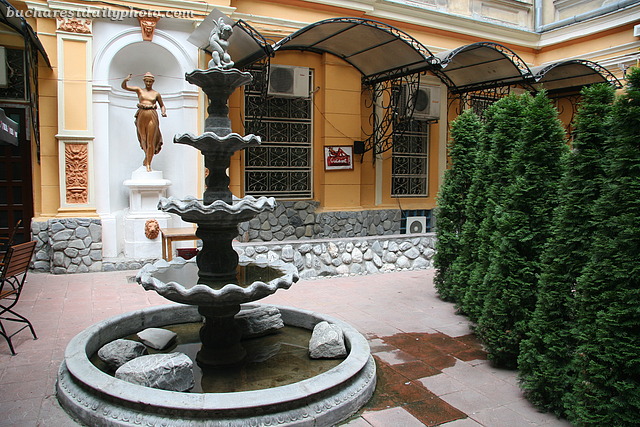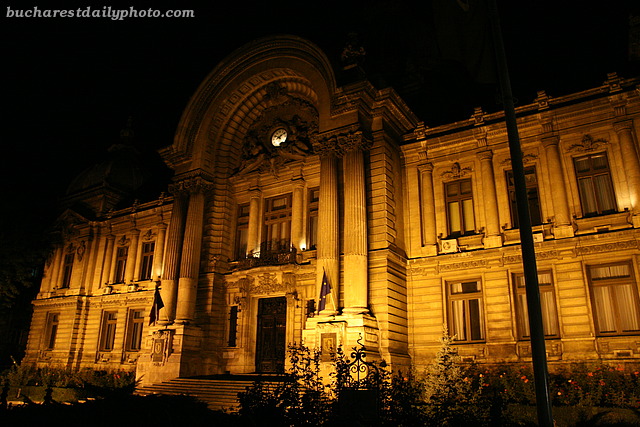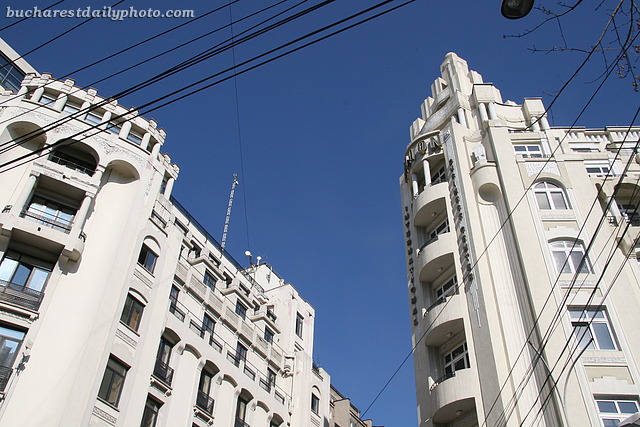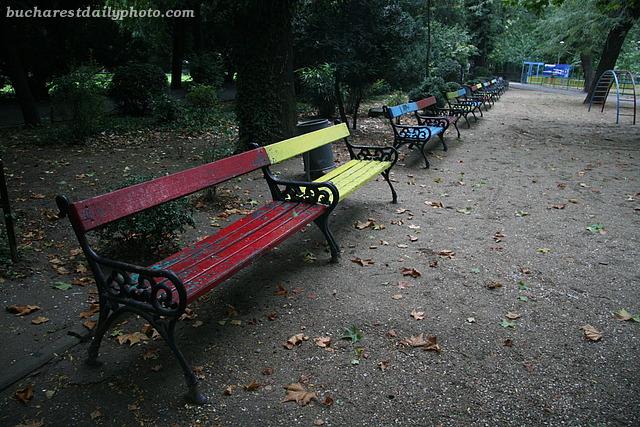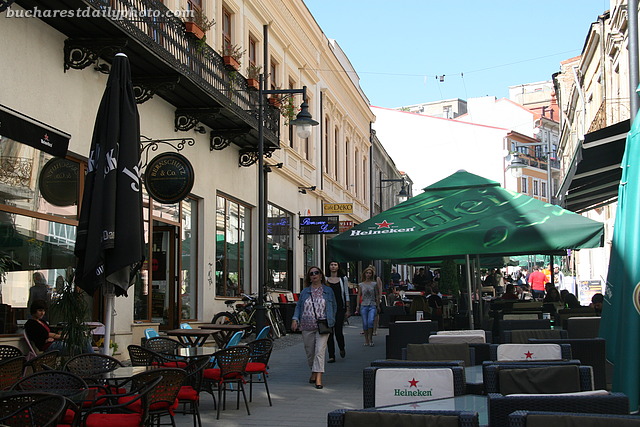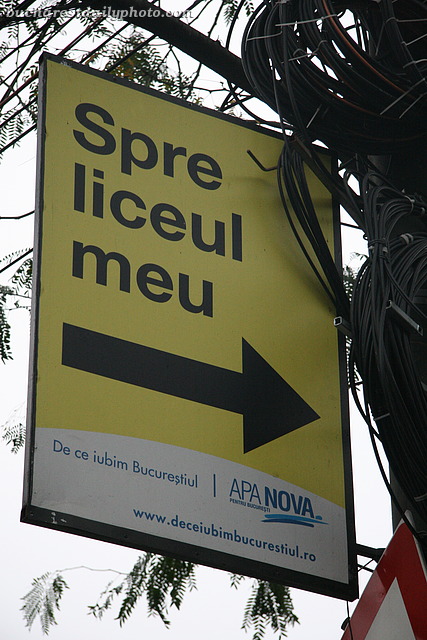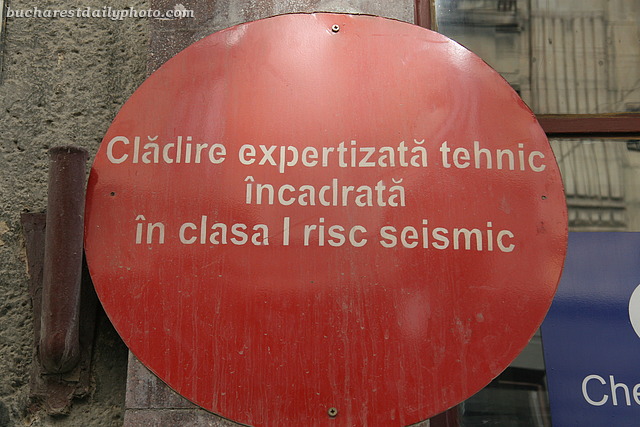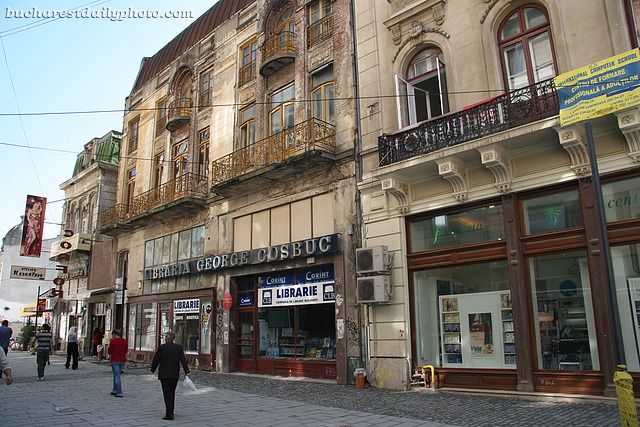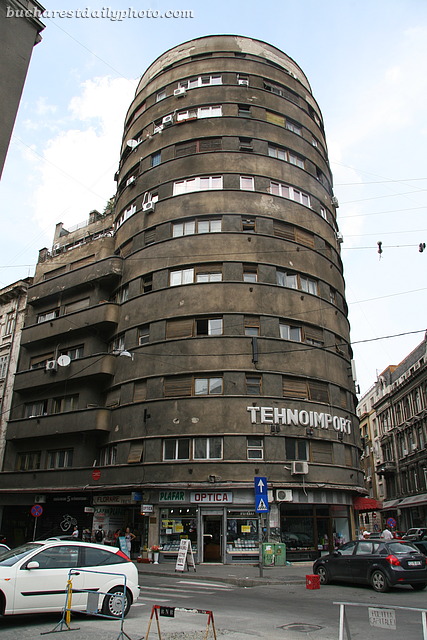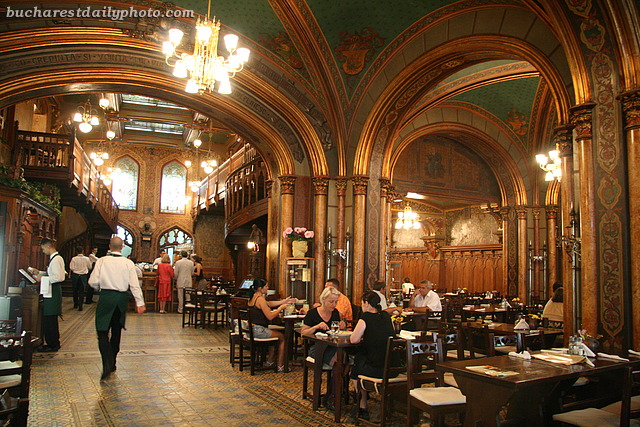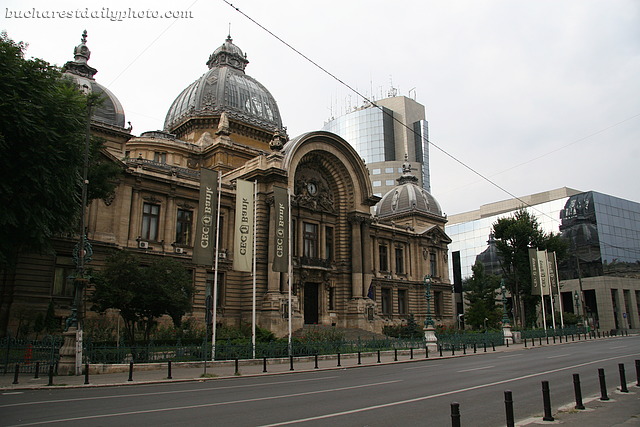To be honest I didn’t know the place in today’s photo existed until a few weeks ago. I must have passed the entrance to this inner courtyard a thousand times but it never crossed my mind to take the few steps through the entrance passageway. But last time I passed this building I stopped to take a picture of the marble plaque that identifies the building as “the house where the poet Mihai Eminescu (who is considered Romania’s greatest poet) worked as an editor to the newspaper The Time between the years 1877 – 1879″ and decided to see what’s behind the narrow passage to the right of the plaque. What I found was this nice inner courtyard, with a fountain and a bronze statue. The building that forms the inner courtyard used to belong to the Dacia Insurance Company and it was built in 1874.
Continuing the nightly stroll on Victory Road, here’s a shot of the Romanian Savings Bank, which I already introduced a few days ago with this post. Designed in eclectic style by the French architect Paul Gottereau and raised between the years 1896-1900, this was the only bank that was allowed to do business during communism when it served as the state savings bank called “CEC” (“Casa de Economii şi Consemnaţiuni” in Romanian) where people used to keep their savings. After the 1990 Revolution, when other banks were allowed to open offices in Romania, the CEC lost many of its customers. The bank was privatized and now it’s called “CEC Bank”. I’ve read in the newspaper that the building is set to become a museum but at this moment is still used as a bank.
Victory Road at night – Part 1
Victory Road at night – Part 2
Victory Road at night – Part 3
I’ve already posted two examples (one and two) of Bucharest’s between the wars architecture. At that time the city was enjoying economic prosperity and new architectural ideas, like modernist and Art-Deco styles, were being promoted. Here are two more examples (in one photo) of Bucharest’s 1930s architecture; and this time the buildings have been renovated. To the left we have Hotel Stănescu (or Negoiu) and to the right Hotel Union. They were built in 1929-1931 after a design by architect Arghir Culina. They served as hotels until 1990 (if I’m not mistaken) and today they function as business centers. They are located at the intersection between Ion Câmpineanu Street and Academiei.
I wonder if the intention in painting these benches in Cişmigiu Park in red, yellow and blue was to make them look like the Romanian flag? In this case they should be grouped in threes rather than twos.
After a gloomy weekend, the sun decided to make an appearance on Monday, which turned out to be a pretty beautiful day. In the afternoon I went out to enjoy the sun and saw that the city was buzzing with people enjoying the nice weather. On my stroll around the old town I noticed the terraces on Smârdan were just starting to fill up. On a previous post I was talking about the on-going renovation of the Old Town. Even though the project is far from being over, this year the Old Town saw an explosion of new cafes, bars, clubs and restaurants. Many of these new establishments lie on Smârdan Street, which is the subject of my photo of the day. Smârdan has already been repaved and all summer it served as one of the favourite evening meeting places in Bucharest. Compared to other outing areas of Bucharest the neighborhood still has a laid back vibe that I like. Trying to navigate the street on a Saturday night proves a mighty task because tables fill the street wall to wall.
About two years ago Bucharest’s water supply company, “Apa Nova”, initiated a social advertising campaign titled “Why we love Bucharest”, meant to make the citizens of Bucharest feel a little better about living in this crazy and chaotic city. As part of their campaign there were signs posted all over the city reading “This is where I went to my first party”, “The street where I first kissed Ana” or “The street where I rode my first bicycle” etc. Some of these ads actually looked like street signs and a friend told me that he saw a pair of confused Germans tourists trying to find the “Street where my grandma lived” on a map – without being successful, of course 🙂 I liked the campaign and meant to photograph some of the signs but I was away from Bucharest for some time and when I returned the campaign was over and the signs were removed. But yesterday I was strolling on Ştirbei Vodă Street and run into this sign, left here probably from two years ago. The sign reads “The way to my high school”.
I wrote yesterday about the red dot and I thought a good idea to post a close up of it. Like I said, it reads “This building has been appraised by technical expertise to fall within seismic risk class I” and this means high risk of collapse in case of an earthquake of magnitude 7 of higher on Richter scale. Many of the historical buildings of Bucharest were built before World War II and were never reinforced. Some of them don’t have a foundation or have very shallow foundations and have already been through two major earthquakes (the one in 1977 and another one in 1940 of magnitude 7.7). After the 1977 earthquake, the government imposed tougher construction standards. Earthquake is always on the minds of citizens of Bucharest and people always ask if the building “has a dot” when looking for an apartment. Evidently, being marked with a red dot diminishes the value of a property and some owners will tell you that their house or apartment was wrongly labeled because of the city hall corruption and that for some reason someone wanted to lower the value of their property. But, conspiracy theory or not, who is willing to take the risk ? I’ve also heard of stories of owners who used influence on the authorities and succeeded in having the red dot removed. I don’t know if these urban legends are true or not, but my advice for those who wish to buy property in Bucharest is to bring an independent expert to do a technical evaluation.
The second photo is of the building with the red dot (on Lipscani Street).
Many first-class modernist and Art-Deco buildings were erected in Bucharest between 1920 and the beginning of the WWII. Among them, this cylindrical tower on Doamnei Street designed by architect H. Stern in 1935. You don’t get to see many buildings like this one and that is why I like it despite its shabby look and dire need for renovation. Unfortunately the red dot at the base of the building tells us that the tower is most likely doomed. The red dot reads “This building has been appraised by technical expertise to fall within seismic risk class I”. I don’t know if you are aware but Romania (especially its southern part) lies in an earthquake area. The last big earthquake was in 1977. It had a magnitude of 7.2 and it killed around 1600 people and about 35.000 buildings were damaged.The buildings appraised as class I present a major risk of collapse in case of an earthquake of magnitude 7 of higher on Richter scale. Since more than 30 years have passed since the last big one, people are whispering that there’s time for the next one. Every year some fortune teller predicts the day the next big earthquake will take place and many people living in buildings like the one in today’s photo take to the streets for the day “just in case”.
When asked to recommend a restaurant for someone from out of town most Bucharestians would probably pick this one. “The Beer Cart” (Carul cu bere in Romanian) is the flagship of Romanian restaurants in the old town. If you are a tourist not knowing any local, you are still most likely to end up here because this restaurant is in all the guidebooks. Fashioned to look like a German beerhouse, Caru cu bere has an elegant facade and a beautiful interior rich with frescoes, stained glass, balconies and ornate woodwork. The restaurant has first opened in 1879. It is packed every night, so you definitely need a reservation especially if you want to dine in the nonsmoking section (which shows that there are probably more foreigners dining here than Romanians). In the summer they have a terrace. The food here is standard Romanian fare, not fine dining, but usually you won’t leave disappointed. Big portions so make sure you leave space for desert. Despite looking so fanciful, I don’t believe it’s an expensive restaurant, but that of course depends on what you order. For lunch time they have a student menu (when you show you student card) and a menu for retired people (with pension coupon) for the equivalent of $8 and a daily lunch menu for business people for about $10. In the evenings they have a show with traditional dances.
Yesterday was Theme Day at the City Daily Blog community, a monthly event that happens the first day of every month, when all participating blogs are posting a picture that relates to the theme day’s description. Just fresh back from vacation, and half asleep for half of the day, I completely forgot about it 🙁 So I decided to post a theme photo today. The theme for this month was “Contrast” and I’ve seen people interpreted it in different ways. Contrast in colors, contrast in sizes, old versus new etc. My picture for today shows old versus new architecture. We have here two banks: the old one, the “Romanian Savings Bank:”, was designed in eclectic style by the French architect Paul Gottereau and raised between the years 1896-1900; the new one, in the background, named “Bucharest Financial Plaza”, designed by Ruxandra Fotino and Sorin Ştefănescu, was built almost 100 years later, in 1994-1996, being the first tall building in the historic center.
